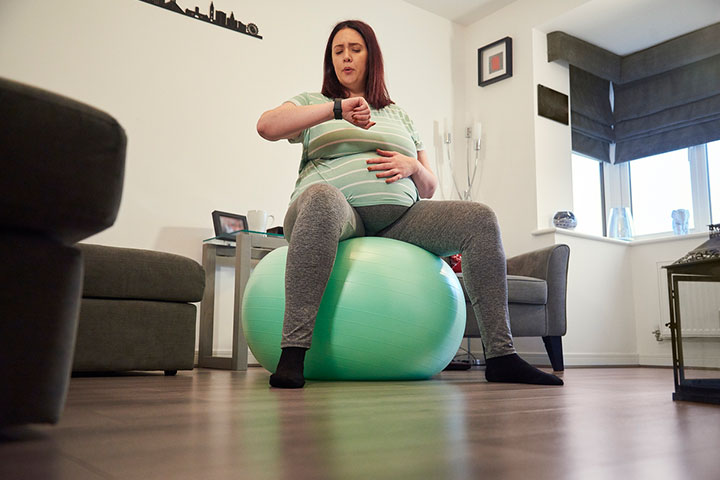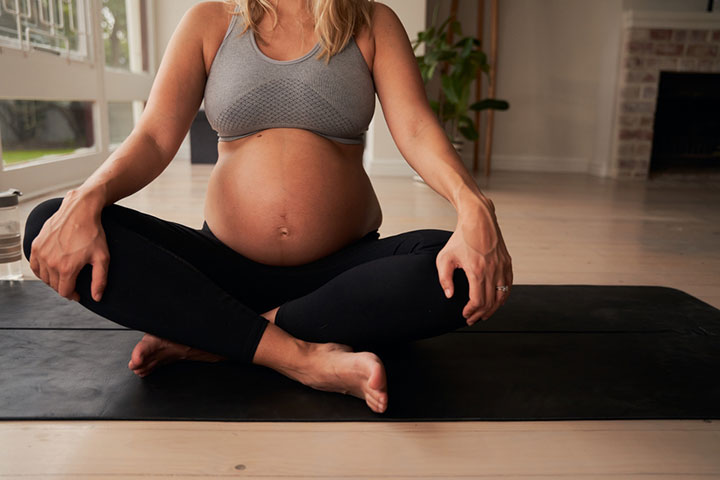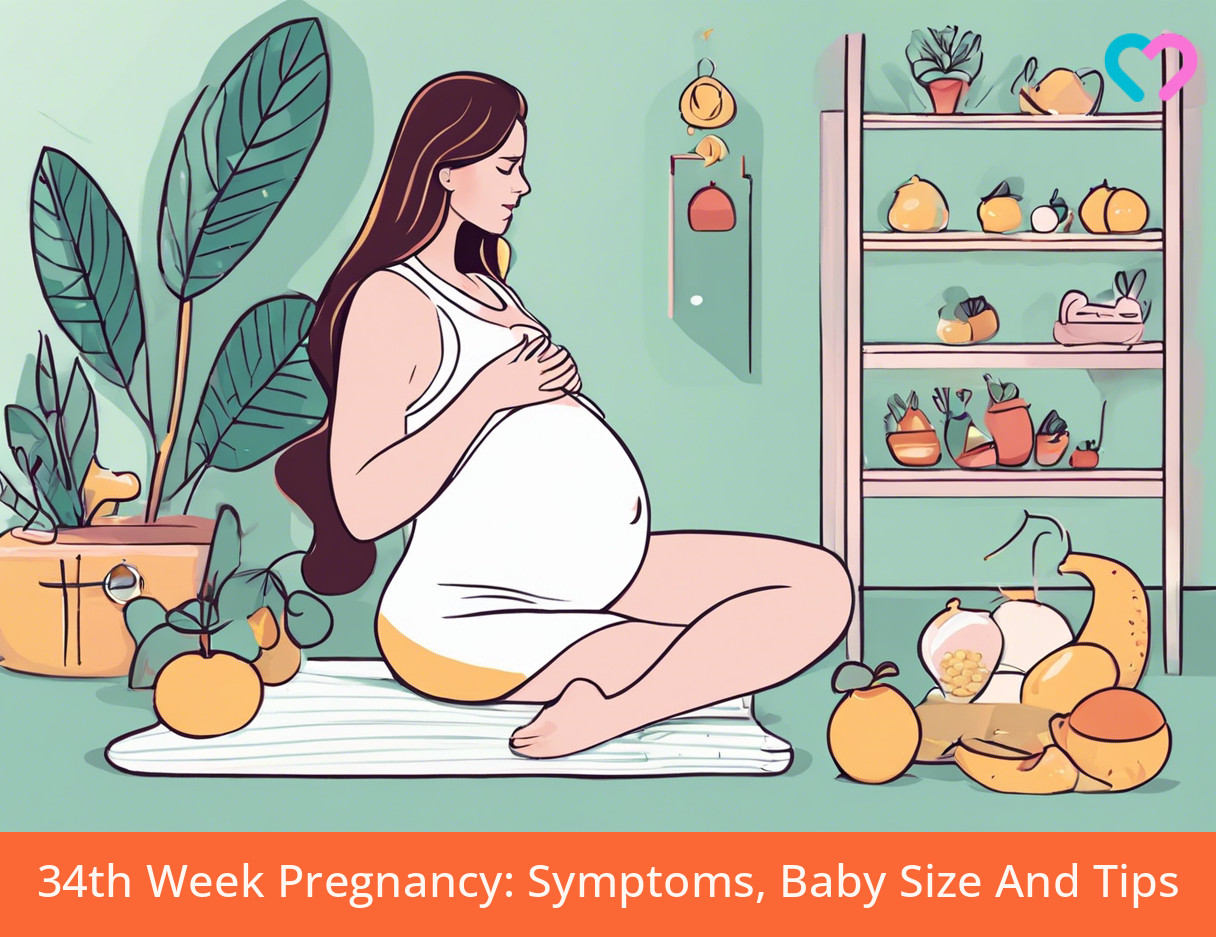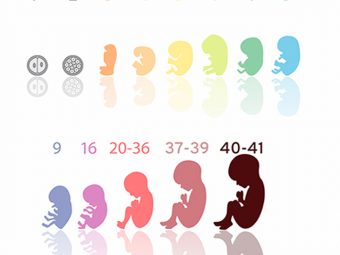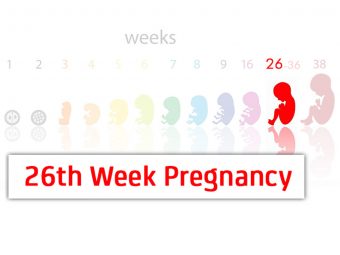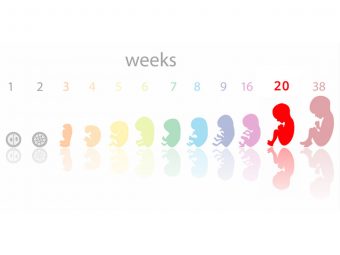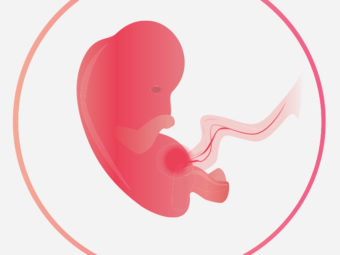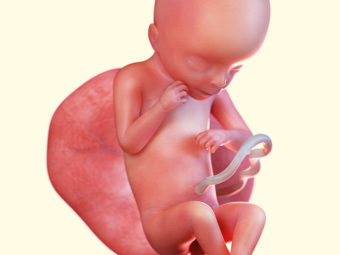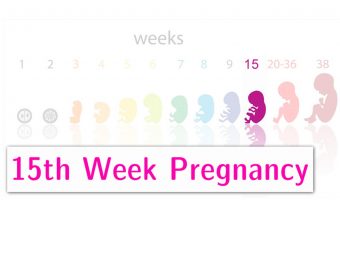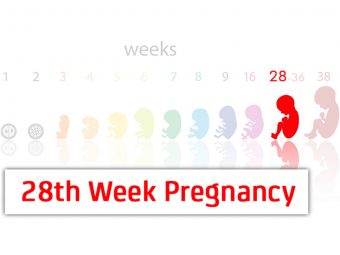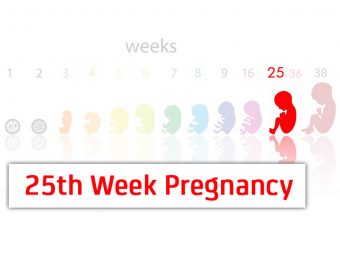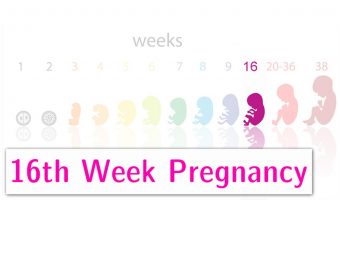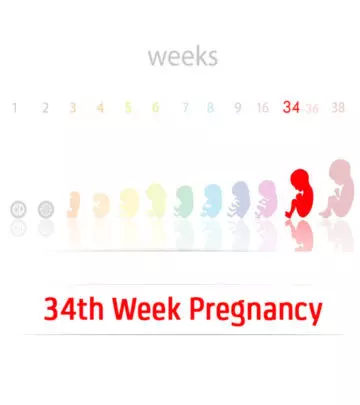
Image: Shutterstock
How Many Months Pregnant Are You At 34 Weeks?
At 34 weeks, you are in the eighth month, i.e., the third trimester of pregnancy and you are nearing your due date.
MomJunction explains how your body is changing and your baby’s development among other things you will experience this week.
How Big Is Your Baby At 34 Weeks?
Your baby is the size of a cantaloupe (muskmelon) by this week (1). He or she measures around 12.6in (32cm) from crown to rump and weighs about 5lb (2.25kg) (2).
Read on to know about your baby’s development this week.
Baby Development At 34th Week Of Pregnancy
| Baby organs | Development stage |
|---|---|
| Skin (3) | Is pink and smooth, and protected by a greasy coating called vernix (4). |
| Face | Features are distinct. |
| Nails | Reach the fingertips. |
| Limbs | Fully developed. Baby kicks get stronger by this time. Sucking movements are seen through the scan. |
| Lungs | It is almost developed (1). |
| Eyes | The baby’s eyes are blue and remain like that until they are exposed to light, and the iris goes through the pigmentation process. After exposure to light for a few weeks, the color may either remain blue or change to a different permanent color (5). |
| Lanugo (6) | The hair protecting the baby’s skin is almost gone. |
| Genitals | In boys, the testicles will descend from the abdomen into the scrotum. |
| Brain | Is still developing. |
 Quick fact
Quick factAs the baby continues to grow inside you, you may experience certain symptoms.
What Symptoms Of Pregnancy Do You Experience At 34 Weeks?
Here are some symptoms you might experience this week:
- Fatigue: The additional weight of the baby leaves you fatigued, all the more so in the case of twins.
- Constipation: Progesterone relaxes the muscles of the bowel, which causes the food to remain in the digestive tract for a longer time. This jams the tract and disrupts its normal activity, resulting in constipation.
- Hemorrhoids: The increasing weight of the baby puts pressure on the veins around the rectal area, causing swollen veins or hemorrhoids (7). Constipation can also add to the pressure, causing the veins to bulge.
- Swelling or edema: Accumulation of body fluids in the tissues due to an increased flow of blood causes swelling of the feet and ankles. Weight gain can also cause swollen feet.
- Abdominal pressure: As the baby drops down into the pelvis, you will experience pressure in the lower abdomen.
- Frequent urination: The pressure exerted by the enlarged uterus on the bladder increases the urge for urination.
- Insomnia: Leg cramps and frequent urination disturb your sleep, causing insomnia. A warm bath and a cup of warm milk before going to bed can help you sleep better. Keeping pillows between your legs will also help.
- Nesting: While not all women experience nesting, it is a common and strong desire to prepare their home for the new arrival, particularly in the final trimester and last weeks of pregnancy.
 Quick tip
Quick tip- Colostrum leak: The breast starts secreting a few drops of yellowish liquid called colostrum. It is the pre-milk that your baby drinks soon after delivery.
- Healthy tresses: Hair loss ceases during pregnancy, making your tresses look voluminous and shiny.
- Shortness of breath: As the belly gets bigger, it exerts pressure on the diaphragm causing difficulty in breathing.
- Backache: The growing baby puts more pressure on the lower back causing backache. Stretching and walking can help ease the discomfort. Also, avoid sitting in one position for long hours.
- Leg cramps: You have cramps usually at night. Stretching your legs and walking can help relieve the discomfort.
- Increased vaginal discharge: Towards the later stages of pregnancy, the cervix and the vaginal walls tend to soften to stimulate the vaginal discharge. The walls have extra discharge because of increased blood flow (8).
- Heartburn: The pressure exerted on the stomach by the growing baby, pushes the gastric acids to the esophagus causing heartburn.
- Braxton Hicks contractions: During this week, you might start experiencing contractions that are not regular. If the contractions are regular, occur for an hour or more, and are accompanied by vaginal bleeding or lower back pain, then it might indicate preterm labor (9). Make sure to call your doctor right away. With the pregnancy progressing, your body also continues to change. Let us read about it here.
Julia Goolia, a mother of four, describes the Braxton Hicks contractions that she felt during her 34th week of pregnancy. She says, “Definitely having more Braxton Hicks contractions in the past week, especially when walking, standing up, when I have to pee, or seemingly for no reason at all. They are strong enough to catch my attention but not scary or anything. I feel him kicking my bladder directly many times a day and I am peeing more than ever (i).”
Changes In The Body During The 34th Week Of Pregnancy
As you enter the 34th week of pregnancy, you notice many physical and mental changes taking place in your body.
- The baby bump is bigger, and the baby will in most cases acquire a head-down position near the pelvis.
Image: IStock
- The breast gets enlarged and fuller as you near the due date. It also feels itchy sometimes, due to the stretching of the skin in that area. You may need a bigger bra to support your breasts.
- The areolas and the nipples get darker and erect.
- Stretch marks become more distinct as the belly grows. These marks result from the tiny tears of the tissues under the skin and make the tummy itchy. Using a moisturizer or a soothing cream, or a calamine lotion can provide some relief. You may also add oatmeal to warm bath water and soak yourself in it.
- Blue veins become distinct around your breasts and the thighs. They appear as the supply of blood to these areas increases.
 Quick tip
Quick tipIn the case of a twin pregnancy, 34 weeks is just three weeks away from the due date because 37 weeks is considered full-term.
During these weeks, your baby will also try to attain the right position inside the womb for delivery. Keep reading to know more about the fetal movement and position it takes this week.
Fetal Movement And Position At 34th Week Of Pregnancy
Movement: By the 34th week of pregnancy, the fetal movements are fewer compared to before, because of insufficient space inside the belly and because the baby tends to sleep more this week.
Position: By this week, the baby moves down into the pelvis in a head-down position, with legs folded up and chin tucked into the chest (11). It is the ideal position for birthing, also called cephalic presentation.
But in some cases, the baby may attain an inappropriate position that makes delivery complicated. A breech position (wherein the foot points towards the birthing canal) or a transverse lie position (wherein the baby lies sideways) calls for medical interventions.
Identifying The Signs Of Labor At 34 Weeks
Preterm labor occurs before 37 weeks of pregnancy. Some of the signs of preterm labor during this week include (12):
- Five or more contractions in one hour.
- Water leaks from the vagina, indicating water break
- Abdominal cramping with or without diarrhea, leading to excessive contractions
- Pelvic cramping, similar to that of menstrual cramps, in a rhythmic pattern
- Pelvic pressure
- Lower backache that is constant or intermittent
- Vaginal discharge with a pink tint or streaks of blood, increase in discharge, or a change in its consistency
- Thinning or shortening of the cervix (effacement) and cervical dilatation.
The next section tells you how to deal with labor signs, should you experience them this week.
Tips To Deal With The Labor Signs At 34 Weeks
Here are some measures you can take when you have the labor signs:
- Contractions: As soon as you start feeling the contractions, walk around or lie down on your left side and see if they get stronger and frequent. If it is false labor, then the contractions will go away as you start walking. Otherwise, note the number of contractions you experience and let the doctor know about it. The doctor might give you medication to stop the contractions if there are no pregnancy complications.
Image: IStock
- Water break: If you experience a continuous watery discharge, then place a sanitary pad in your underwear to prevent any infection. When the water breaks, you are predisposed to infections that can affect both you and your baby. So use a sanitary pad to prevent infections and visit the hospital immediately.
- Bleeding: If you notice any vaginal bleeding, use a pad and get to the delivery center. This will also help the doctor to check for any placental rupture.
- Pelvic or back pain: If you have pelvic or back pain, gently massage that area or use a warm compress for relief. If the pain persists, then contact your doctor.
If the doctor confirms that you are in labor, the baby will be delivered prematurely. Babies born this week will be fine if they weigh appropriate and are healthy. The average weight of babies born at 34 weeks is around 2500g, and their survival rate can be as high as 95% (13). According to the Centers for Disease Control and Prevention (CDC), about 1 in 10 babies born in the United States in 2021 had a preterm birth.
However, preterm babies will need some extra care to breathe and feed well. The baby will need to be closely monitored for a few days, which calls for an extended stay in the hospital.
In addition to the above signs, you have to see the doctor under a few other circumstances.
When to call the doctor
Call your doctor if:
- There is any noticeable change in your baby’s movement patterns or the movements have decreased.
- You experience sudden weight gain, swelling of hands and face, blurred vision, persistent headache, breathlessness, lightheadedness, and abdominal pain.
- The color of the urine is dark yellowish or orange with or without odor and is accompanied by abdominal or lower back pain.
- You have a burning sensation or vaginal itching, which could indicate UTI.
- You feel extremely thirsty and dryness in the mouth, along with blurred vision, fatigue, and dizziness.
- You notice unilateral swelling with or without pain and tenderness in the leg.
If you do not have any signs of labor or other uncommon changes, it means that your pregnancy is progressing smoothly. In such case, you can schedule a routine OB/GYN visit when it is due.
Keep reading to know what to expect during your OB/GYN visit this week.
OB/GYN Visit: Pregnancy Tests At 34 Weeks
In addition to the routine check-ups like blood pressure and weight check, the following tests are carried out in the 34th week of pregnancy.
Ultrasound: An ultrasound during the 34th week helps to check for complications such as a low lying placenta. It also helps assess the position and health of the baby.
Non-stress test: It is carried out between the 33rd and 34th week, or sometimes in the 28th week. It is the recording of the fetal heartbeat that helps the doctor know about fetal development and well-being (14).
Rh type test: A blood test to determine your Rh type is usually done in early pregnancy (15). If your Rh type is negative and your baby is Rh-positive, your baby’s health could be at risk. But since the blood type of the baby cannot be known until birth, you will be given an Anti-D injection during 26-28 weeks and 34-36 weeks of pregnancy to minimize the health risks. This injection helps you develop immunity to Rh-positive blood.
After birth, the blood from the umbilical cord is tested to determine the Rh type of the infant. If your baby is Rh positive and you are Rh negative, then you will be given another shot of Anti-D.
Group B strep test: A screening test of the vaginal swab is done during this week to check for Streptococcus group B infection. If you are diagnosed with GBS, then antibiotics will be given when your labor starts. This will reduce any risk to the baby (16).
As your body is working hard to nurture the tiny life inside you, you need to continue having the right diet. Next, we give you some nutritional and wellness tips to follow during the 34th week.
Did You Know?
The placental blood flow to the fetus increases throughout the pregnancy and is around 600-700 ml/min at the term (17).
Around 80% of babies are born between 38 and 42 weeks of pregnancy and 5% on the actual due date (18).
The placental blood vessels can grow up to 320 kilometers at full term miles.
The mother’s and baby’s blood never gets mixed.
Nutrition And Wellness At 34 weeks
Nutrition:
Here is the list of foods that you may continue to have during the 34th week of pregnancy.
- Fruits and vegetables such as bananas, apples, mangoes, spinach, broccoli, etc. that are rich in vitamins and fiber.
- Dairy products such as milk, cheese, and yogurt for calcium.
- Foods rich in carbohydrates including whole meals, bread, pasta, and potatoes. These are a good source of energy. Eating breakfast cereals and whole grain foods can prevent constipation.
- Protein-rich foods including chicken, fish, and egg. Protein helps in building the body tissues.
- Include a lot of green leafy vegetables, brown rice, fortified bread, and cereals in the diet. These are a good source of folic acid.
- Vitamin D can be obtained by consuming eggs and oily fishes. A vitamin supplement containing vitamin D is recommended during this period.
- Avoid tea or coffee while having meals because it makes iron absorption difficult.
- Stay away from junk foods during this week.
Wellness:
In addition to having a healthy diet, you need to engage in physical activities that can keep up your energy level and relax your muscles. Here are some physical activities for prenatal care that you can do during the 34th week of pregnancy:
- Kegel exercises are one of the best exercises to strengthen the pelvic floor muscles. It also helps reduce the laceration rate during vaginal delivery (19).
 Quick tip
Quick tip- Pelvic tilt helps in increasing the flexibility of the abdominal muscles and eases back pain (20).
- Tailor sitting helps in strengthening the thigh and back muscles and improving the blood flow to the lower body. Also called the ‘sitting-while-cross-legged’ exercise, it involves the following steps (21):
Image: Shutterstock
- Sit on the floor with back straight and the soles of your feet together.
- Gently lean your torso forward till you feel a slight stretch in your thigh and hip muscles.
- Count till 5 and move back to original position slowly.
Apart from these exercises, you can go for prenatal yoga, walking, and swimming exercises to strengthen your joints and muscles and prepare you for labor and childbirth.
Keep reading for more tips on how to stay comfortable this week.
Tips For A Healthy 34th-Week Pregnancy
- When in a lying position, get up slowly to avoid any jerky movements. Sudden movements can lower your blood pressure and make you dizzy.
- A warm bath to ease leg cramps, hemorrhoids, and back pain.
- To avoid heartburn, avoid carbonated drinks, spicy and citrus foods.
- Drink less or no water for at least one hour before going to bed to reduce your urge to urinate in the night and sleep soundly.
- Keep track of the baby’s movements and count the number of times your baby kicks in a specific period. It helps you understand the pattern of the baby movements and ensures proper growth of your little one.
- Wear loose and comfortable maternity clothes.
- Visit your doctor on the scheduled appointments and take prenatal vitamins as suggested by them.
- Attend childbirth classes and classes on baby care.
- Book an appointment with a professional masseuse who has experience in handling pregnant women. A massage can help ease your back pain and body aches.
- Start inquiring about cord blood banking. If you are interested, then register for it with a good healthcare center.
- Find out about childbirth and the pain relief options offered by the healthcare center.
- Start looking for baby names.
- Spend time with your partner, family, and friends. Keep yourself in a positive environment.
- Arrange for childcare, if you have an older kid. They can be of great help in taking care of your child.
- Learn more about breastfeeding your baby.
- Explore more about postpartum recovery and care.
Your partner can also lend a helping hand to make life easier for you at this time.
Tips For Dad-to-be
Here is how your partner can help.
- Search for a good pediatrician.
- Help you with the chores and be with you during the prenatal visits.
- Pack the hospital bag with all the necessary stuff and be ready to drive you to the hospital.
- Accompany you during walks and pregnancy classes.
Frequently Asked Questions
1. Do babies born at 34 weeks need NICU?
Since babies born at 34 weeks are premature, they may need to stay in the NICU for one to two weeks. However, their long-term health outcomes are generally similar to full-term infants (22).
2. Do babies move a lot at 34 weeks?
Fetal movements, including kicks, flutters, and rolls, usually become constant at around 32 weeks of gestation. After that, the movements should ideally not increase or decrease much on a daily basis (23).
3. What is the average weight gain for a woman at 34 weeks pregnant?
The average expected maternal weight gain at 34 weeks during the third trimester is between one and two pounds (26).
4. Can a woman still fly during this stage of pregnancy?
Air travel is considered generally safe around 34 weeks. However it is best to confirm with your doctor and obtain a letter from them confirming the safety of travel, any potential complications, and your due date (27).
The 34th week of pregnancy marks the mid of your third trimester, and you are almost near your due date. Your body will show the most changes during this period, and you will also feel your baby’s movements. Therefore, it is of utmost importance that you take extra care of yourself and start preparing yourself for your baby. Ensure that you include fruits and vegetables in your diet so that you get proper energy and nutrition. Also, keep yourself engaged in lightweight physical activity in order to relax your muscles.
Infographic: How To Have A Healthy 34th Week Pregnancy?
Being in the 34th week means that you’re already in your third trimester, and the anticipation of giving birth is growing at this stage. It is still crucial to prioritize your health and nutrition at this stage of pregnancy. The infographic below includes some useful advice for a healthy 34th week of pregnancy.
Illustration: Momjunction Design Team
Key Pointers
- The baby measures 12.6 inches in length, weighs 5lb and is the size of a cantaloupe.
- Symptoms include fatigue, constipation, edema, frequent urination, backache, and insomnia.
- Preterm labor could be indicated by experiencing more than five contractions in an hour or noticing water leakage from the vagina.
- Seek immediate medical attention in case of changes in the fetal movement pattern, or experience sudden weight gain, pain, swelling, or breathlessness.
Image: Stable Diffusion/MomJunction Design Team
Pregnant and in pain? Learn what you can do to ease lower back and pelvic pain at 34 weeks. Get tips and advice to help you feel better.
Personal Experience: Source
MomJunction articles include first-hand experiences to provide you with better insights through real-life narratives. Here are the sources of personal accounts referenced in this article.
i. 34 weeks/baby#4.https://julia-transition.blogspot.com/2017/05/34-weeks-baby-4.html
References
1. T. Milles; Week by Week Fetus Size Demonstrated by Fruits; Expecting Parents Alliance Of America
2. Your Baby’s Development; Kids Health
3. Fetal Growth And Development – Week 34; South Dakota Department of Health (1995)
4. Pregnancy Week By Week; Due Date Calculator
5. Your baby’s development; C&G baby club
6. Your pregnancy: weeks 33 to 36; Kaiser Permanente
7. Pregnancy and Your Vision; Prevent Blindness
8. Glossary – Hemorrhoids; US Department Of Health And Human Services
9. Vaginal discharge in pregnancy; NHS
10. Pregnancy – 33 to 36 weeks; Healthdirect Australia
11. Your pregnancy week by week; NHS
12. Preterm Labor – Know The Signs And Symptoms; Marshfield Clinic Health System
13. Information for parents of preterm babies
at 31 to 34 weeks gestation; McMaster Children’s Hospital
14. Non-Stress Tests Measure Your Baby’s Movements, Heart Rate; Cleveland Clinic
15. 34 Weeks Pregnant; Raising Children Network (Australia)
16. Group B Strep During Pregnancy:Care Instructions; Kaiser Foundation Health Plan, Inc
17. Placental Blood Circulation; Morgan & Claypool Life Sciences (2010)
18. Overdue baby – what happens if my baby is late?; NCT
19. Effects of Prenatal Perineal Massage and Kegel Exercises on the Integrity of Postnatal Perine; Scientific Research Open Access
20. Pelvic Tilt, Leg Lift for Back Pain During Pregnancy; Mount Nittany Health
21. Tailor Sit, Trunk Turn for Back Pain During Pregnancy; Fairview Health Services
22. WHEN IS IT SAFE TO DELIVER YOUR BABY? University of Utah
23. Alive and Kicking – Recognizing the Signs of Reduced Fetal Movement; Lamaze.org
24. Pregnancy Week 34; American Pregnancy Association
25. What Is the Evidence for Perineal Massage During Pregnancy to Prevent Tearing??; Lamaze.org
26. Pregnancy Weight Gain; American Pregnancy Association
27. Travelling in pregnancy; NHS








